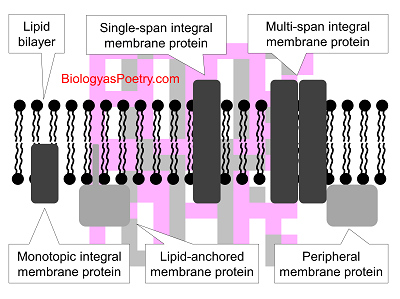∞ generated and posted on 2016.08.24 ∞
Amino acid-based polymeric substance that is found in association with lipid bilayers.
Membrane proteins can be peripherally located, relative to the lipid bilayer – that is, attached only to the surface of the lipid bilayer – or instead can be found to some extent within the interior of the lipid bilayer.

Figure legend: Membrane proteins come in various forms, all of which have in common that they are in some manner associated with lipid bilayers. Integral membrane proteins are anchored into lipid bilayers via the entry of the protein into the lipid bilayer, with hydrophobic R groups found on the outside of these proteins directly interacting with the membrane lipids. Integral membrane proteins can either span the membrane completely, span partially, or span multiple times. Peripheral membrane proteins instead attach to especially proteins that are already membrane associated but peripheral membrane proteins do not themselves span the membrane, even partially. Proteins also can be attached to non-protein, hydrophobic molecules, i.e., lipids, that serve to anchor the membrane protein to the membrane with the protein itself actually entering the lipid bilayer.
All membrane transport proteins fall into the latter category, that is, of membrane protein.